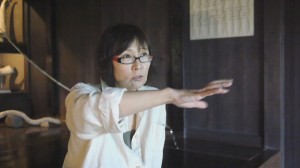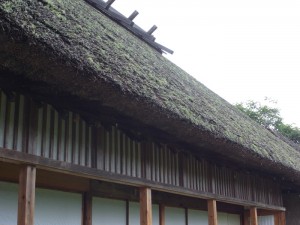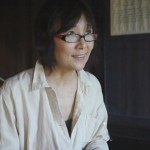古民家オーナーインタビューvol.2
ミュージアム&ギャラリー 風の沢
Kazenosawa as a dojo (training hall)
English here
「古民家びと企画」の古民家オーナーインタビュー第2弾は、宮城県栗原市にある「ミュージアム&ギャラリー 風の沢」のオーナー、杉浦節美さん。10年以上かけて自分達の手で甦らせたという建物と周囲の景色はとても美しく調和しています。存在感のある古民家は古臭さを感じさせず、細部に渡るオーナーの気配りが感じられます。
家族にとっての道場

古いものを知らない若者にとっては、古いものが新しいのだと思います。実際にこういう建物があるから、次の世代に伝えることができる。だから、現代の文明的な物も最低限入れていますが、出来るだけ昔の通りに残そうと思って努力しました。
この建物は、登記は私ですが、幕末からここにあって、高橋家の人達の気配を感じます。守ってくれているのです。高橋家の土地を借り、彼らの記憶をたどって、皆がきてくれる場所にさせて下さい、と思っています。この建物がないと私はない。でも、私がいないとこの建物もない。お互いに向き合って大事にしています。
風の沢で皆さんをお迎えするにあたり、まずは清めて、掃除をします。それが我々の役目です。雑草ボウボウではダメなのです。お寺も必ず掃除で始まるじゃない?ここは家族にとっての道場です。
風の沢に出会う前
10年以上前に東京でギャラリーを始めました。ビルの中の特殊な空間で、一部屋全部が漆塗りの緊張感のある空間です。漆黒の空間の中に灯りをつけています。暗いと、よく見たり、考えたりするじゃないですか。作者が言おうとしていることをよく見て欲しくて提案しています。
絵を描いたり、音を奏でたり、焼き物を焼いたり。私ができないから、表現できる人達のための空間をつくっています。共に学びたい、感じたい、感動したい、喜びたい、自分が生き生きとしたい。人と人が集まって何かが生まれる、という背景を私がプロデュースしています。
生活の中で養われる目

冬は、寒いですよ。マイナス4度ですから。でも電気毛布があるからお布団は暖かです。夏は、東北でも暑いですね。国によっては、情報も少ないし、生活ってそんなもんだと思って生きている子供達もいますよね。孫は今5歳だから小さいけど、間もなくわかるようになるでしょう。
雑草の中でヘビイチゴを増やしていたら、孫が草刈りボランティアの方々に「ばあばの好きなヘビイチゴとったらダメだよ。」と言うのです。雑草を見て「きれいだねーこの花」と言ったりします。あの子らも生活の中で何を大切に育てているのか見ているんですよね。
美しい景色は皆で守る
私は日本に生まれ育ったこと、日本の国を誇りに思っています。何を誇りに思っているのかと言えば、日本人の感性です。これを途絶えさせてはいけない。
やっぱり日本の地方の景色は、守らなければならないと思うのです。以前は、縁側の前には何もなかった。縁側に座ったら、すぱーっと芝生と田んぼがつながって見えていました。ところが、4年前に鉄塔が建ってしまった。東京に電気を運ぶための鉄塔です。こんな里山に通すのはまかりならん!と言ったけれど、建ってしまった。
ある方から「1億円配れば、鉄塔はどこか別のところに行く」と言われました。ここからなくなっても、別のどこかにいくだけ・・・。仕方なく、鉄塔が見えないように木を植えました。
日本の里山は、どこに行っても鉄塔があります。良い景色だと思っても、鉄塔が建っていて写真が撮れないでしょ?もっといろんな努力があるはずです。鉄塔を建てるのに、地権者だけの許可をとれば良いというのはダメ。なぜ日本人は怒らないのか?里山の景色は、皆で守らなければいけません。
風の沢を“東北のへそ”にしたい
 この景色を守り、“東北のへそ”になっていけたらいいなぁという夢を持っています。身を粉にして働けば、米の飯とお天道様はどこへ行ってもついて回る、と親に言われました。後は、自分の夢を持って生きればいいと。この土地は、私に夢を持たせてくれました。後は叶えなきゃいけないと思っています。
この景色を守り、“東北のへそ”になっていけたらいいなぁという夢を持っています。身を粉にして働けば、米の飯とお天道様はどこへ行ってもついて回る、と親に言われました。後は、自分の夢を持って生きればいいと。この土地は、私に夢を持たせてくれました。後は叶えなきゃいけないと思っています。
東京の仕事で得たお金をここに100%つぎ込んでいる訳ですが、いつまでも続きません。今まで試行錯誤でやってきましたが、個人でできる域を超え始めました。ここで働く人達の給料が出るように、今後は、運営する組織づくりをしたいと思っています。
若い人の力を借りたいと思います。新しい風を入れて欲しいのです。皆で知恵を出し合い、日本中の人に賛同して頂き、支えて頂きたいと思っています。そして、発信する場所になれたらいいなと思っています。
万葉祭について
 もともと祭をしようと思っていたわけではなく、3年前の地震(岩手・宮城内陸地震)がきっかけで始めました。人が文明をつくる時、最初は、土と火です。縄文の人は土が固まるのを見て、土器をつくりはじめました。土と火は、文明の原点だと思うのです。そして技術の伝承があり、里山を美しくいかすということがあり、祈り、願い、感謝というのが文化です。だから「土と火のまつり くりはら万葉祭」なんです。
もともと祭をしようと思っていたわけではなく、3年前の地震(岩手・宮城内陸地震)がきっかけで始めました。人が文明をつくる時、最初は、土と火です。縄文の人は土が固まるのを見て、土器をつくりはじめました。土と火は、文明の原点だと思うのです。そして技術の伝承があり、里山を美しくいかすということがあり、祈り、願い、感謝というのが文化です。だから「土と火のまつり くりはら万葉祭」なんです。
宮城県には、「万葉」という名称がついた祭が何箇所かあり、ネットワークしようという話もあります。万葉集の「万葉」は、そこに生きてきた思いや文化、文明です。引き続き私たちはここで何をすべきか考えています。
「古民家びと」へのメッセージ
日本の至る所に古民家はあると思います。築年数はいろいろですが、それらは日本の痕跡でもあるから、残せる人はできるだけ残して欲しいと思います。昔に戻れということではなく、融合させながら、日本の景色と建物をみんなの力で次の世代に残していって欲しいと思います。
ミュージアム&ギャラリー 風の沢
〒987-2302宮城県栗原市一迫片子沢外の沢11 電話:0228-52-2811
風の沢 http://www.kazenosawa.jp/
くりはら万葉祭 http://manyosai.blog16.fc2.com/
杉浦節美さん

能登の商家の生まれ。2000年に20年以上使われていなかった古民家を買い取り、200年前の美しい姿に戻そうと地元の大工さんをはじめ多くの職人さんやお年寄りと一緒に自分達も手伝いながら母屋、馬屋を再生。縁があった栗原の地によその風を吹き込み、新たな栗原の風で、人が集い、表現する空間にするという思いで「風の沢」と名付け、2007年にギャラリーをオープン。2011年には母屋と裏山をミュージアムに、板倉をギャラリーに。さらに今後はCAFÉ&SHOPとSTAGEのオープンを予定。
「風の沢」オーナーさんオススメのスポットはこちら!
周辺おすすめスポット
より大きな地図で 風の沢 を表示 |
この地図の周辺スポットを見る 伊豆沼(宮城県伊豆沼・内沼サンクチュアリセンター) これだけの規模の蓮池はどこにもない。蓮は夏が見ごろ。渡り鳥の飛来地でもあり栗原の大切な池。 所在:宮城県栗原市若柳字上畑岡敷味17-2/電話:0228-33-2216 URL:http://www7.ocn.ne.jp/~izunuma/top/topmenu.html蕎麦祥(手打ち蕎麦 手打ちうどん) 脱サラされたご主人のそばが美味しい。HPには、初めてのお客様には三色そば(1,200円)がオススメとあります。 所在:〒987-2223 宮城県栗原市築館字萩沢52-4URL:http://www.geocities.jp/sobasho124/ 定休日:毎週火曜日キッチン食堂 城山 姉妹でやってるお店。4種類の定食があってどれも美味しい。岩出山に行った際にはオススメ。 所在:〒989-6436 宮城県大崎市岩出山二ノ構6 電話:0229-72-0356 定休日:日曜日・第一水曜日 |
ENGLISH
Cominka People Special Feature Cominka Owner Interview vol.2
Kazenosawa as a dojo (training hall)
Our second Cominka Owner Interview features Setsumi Sugiura, the owner of Museum & Gallery Kazenosawa, in Kurihara, Miyagi. The cominka they refurbished themselves over 10 years is in beautiful harmony with the surrounding landscape. It gives no sense of being out of date, with every detail of it being taken care of.
Dojo for the family
For young people who don’t know old things, the old is the new. With the actual building, I can convey it to the next generation. So I did my best to keep it as it was, with minimum intervention.
This building is registered as my building, but it’s been standing since 19th century and I do feel the presence of the original owner family. They are protecting us. I see us as only borrowing their land, trying to produce a place where people gather, trailing their memories. Without this building I don’t exist, and vice versa. Facing each other, we are taking good care of each other.
As we have our guests, the first thing we do is to purify and clean. That’s our role. You can’t leave the grass untouched. Temple starts their day with cleaning, right? This building is a dojo for our family.
Before encountering Kazenosawa
More than 10 years ago, I started a gallery in Tokyo. It’s a very special space in a building, with the whole room coated with lacquer, generating tension. So the room is black and lit. One sees and thinks better in dark, you know. I want the visitors to see well what the artist is trying to say.
Painting, playing music, making potteries… I can’t do these things myself, so I’m making a space for those who can express. Sharing learning opportunity, feeling, emotion, happiness and being positive. I’m producing a setting with which people gather and something starts.
Senses nurtured in everyday life
It’s cold in winter. It gets as cold as -4℃. But as we have electric blanket, it’s warm in bed. The summer’s fairly hot even in Tohoku. We don’t get a lot of information and some kids are just believing that’s how life is. My grandson is 5 years old now, and he will see it soon. I was growing hautboy strawberry in weed, and when a volunteering people were weeding, he was telling them “Don’t take hautboy strawberry. Granny likes it.” He says things like “what a beautiful flower”, looking at weed. They are seeing in everyday life what we are treating importantly.
Beautiful landscape is to be protected by community
I’m proud of being born and raised in Japan, and of Japan itself. If someone asks me what are you proud of, I would say Japanese sensitivity. We can’t just let it die.
I do believe the landscape of Japanese countryside is something we have to preserve. Before, in front of this cominka there was nothing. When you look out, you could see all the grass and rice fields connected. But 4 years ago, they erected a power line tower – tower that is for bringing electricity to Tokyo. I objected, saying you can’t do this in countryside like this, but eventually they built it.
Somebody told me “if you give out 100,000,000 yen ($1.3m), the tower will go somewhere else.” It might disappear from here, but it will be there somewhere… I chose to plant trees not to see the tower.
Those towers are everywhere in Japanese countryside. Even when you find a landscape nice, you don’t want to take a photo if there is a tower, right? There should be other possibilities. It is totally wrong to assume you need permission to build a power line tower only from the land owner. I can’t understand why Japanese people don’t get angry about it. The landscape of the countryside is to be protected by the community.
I want to make Kazenosawa the belly button of Tohoku.
My dream is to preserve this landscape and become the "Belly button of Tohoku". My parents would tell me "if you work hard enough, food and the sun will always follow you. All you are left to do is to have a dream". This land gave me the dream. Now I have to make it come true. I've been putting all the money I earn in Tokyo to here, but things can't go on like this for long. I've been experimenting but now things are becoming larger than an individual can handle. What I have to do now is to build a managing organization that can pay the salary of people working here.
I need hands of young people, new blood. I want everyone to take part in coming up with ideas, I would like everybody in Japan to support and sustain us, eventually becoming a place where people can send out information.
On Manyosai Festival
Originally I was not thinking of doing any festival, but the earthquake of 3 years ago (Iwate-Miyagi Earthquake) triggered it. A civilization starts with the earth and the fire. Our ancestors started to make clay pot having seen the earth becoming solid. I believe the earth and the fire are the origin of civilization. Then there is handing down of techniques, using the countryside beautifully, praying, wishing and appreciation - that's culture. Hence I named it "Festival of the Earth and the Fire - Kurihara Manyosai".
In Miyagi, there are some other festivals with "Manyo" in their names, and we are talking about networking each other. "Manyo"(literally translates thousands of leaves) in Manyoshu signifies all the culture and civilization that have lived there. We are still asking ourselves questions of what we should do here.
Message to Cominka People
I think there are cominkas in many places in Japan. Different age they may be in, they are traces of Japan. So I want the owners to preserve them if possible. I'm not saying we should all get back to old times, but we should integrate them into our contemporary life, and hand down Japanese landscape and buildings to the next generation.
Setsumi Sugiura
Born in a merchant family of Noto, Sugiura is the owner of Kazenosawa, flower arrangement artist and the owner of a real estate agent in Tokyo. In 2000, she bought a cominka which had been abandoned for more than 20 years, restoring how it looked 200 years ago with local carpenters and craftsmen. In 2007, she opened Kazenosawa Gallery - the name "wind stream" signifying her hope to make it the place which brings in new wind to Kurihara, offering space for gathering and expression. In 2011, she opened the main building and the backyard as museum, kura as gallery, with cafe, shop and stage planned to open in the future.
987-2302
11, Sotonosawa, Katakozawa, Ichihazama, Kurihara, Miyagi
81-228-52-2811
Kazenosawa http://www.kazenosawa.jp/
Kurihara Manyosai http://manyosai.blog16.fc2.com/
Here are places the owner of Kazenosawa recommends!
Lake Izunuma
(Miyagi Izunuma-Uchinuma Sanctuary Center)
Address: 17-2, Shikimi, Aza-Kamihataoka, Wakayanagi, Kurihara, Miyagi
ZIP: 989-5504
Tel: +81-228-33-2216
URL:http://www7.ocn.ne.jp/~izunuma/top/topmenu.html
Owner's comment:There is no other lotus lake of this scale. The high season for lotus is summer. It is also a home for migrant, and a very important lake for Kurihara.
Sobasho
52-4, Aza-Hagisawa, Tsukidate, Kurihara, Miyagi
ZIP: 987-2223
URL:http://www.geocities.jp/sobasho124/
Closed on Tuesdays
Owner's comment: The ex-businessman chef makes really good soba.
Shiroyama
6, Ninomizo, Iwadeyama, Osaki, Miyagi
ZIP: 989-6436
+81-229-72-0356
Closed on Sundays and the 1st Wednesday of the month
Owner's comment: A restaurant run by sisters. They have 4 meal sets and they are all good. If you go to Iwadeyama, it's a place to go!


